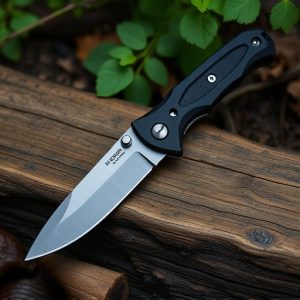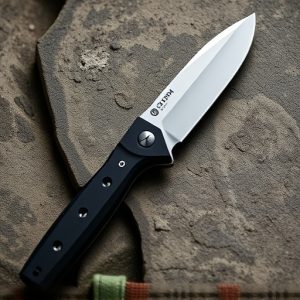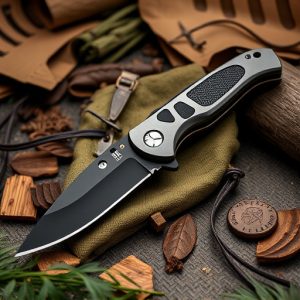Mastering the OTF Automatic Knife: Mechanisms, Legality, and Maintenance
An OTF (Out The Front) automatic knife is a sophisticated tool that combines advanced engineering w…….
An OTF (Out The Front) automatic knife is a sophisticated tool that combines advanced engineering with user-friendly design. It features a spring-loaded blade that deploys swiftly with the press of a button, gliding out of the handle through a guided path for precise and controlled release. These knives are crafted from high-quality stainless steel or titanium for durability and have ergonomic handles to ensure a secure grip under various conditions. Their self-contained design eliminates external moving parts, which enhances reliability by maintaining the blade's sharpness and readiness for immediate use. Legal considerations are paramount when owning an OTF knife; users must adhere to federal, state, and local laws that govern their possession, as they can be classified differently in different jurisdictions, ranging from novelty items to defensive tools. Proper training on safe handling is essential due to the risk of unintended deployments.
The history of the OTF automatic knife is rich with technological advancements and legal evolutions, from early 19th-century patents to today's high-performance models. The mid-20th century saw improvements in safety and functionality, while the subsequent decades balanced innovation with increasing legal restrictions. Today, OTF knives are subject to strict regulations that reflect contemporary attitudes towards personal safety and automated devices.
For optimal performance and safety, a high-quality OTF knife should be made from premium steel like CPM S35VN or S45VN, have a functional blade shape for both everyday carry and tactical situations, include a reliable automatic mechanism with internal safety locks, and feature an ergonomic handle. Regular maintenance is crucial to maintain functionality; this includes cleaning, drying, lubricating, and inspecting the knife after each use and in accordance with the manufacturer's guidelines. By following local laws, maintaining the knife properly, and handling it responsibly, an OTF automatic knife can be a dependable tool for a variety of tasks over its long service life.
Explore the intricate world of the automatic out the front (OTF) knife, a marvel of modern engineering and design. This article delves into the inner workings, functionality, and legal implications of owning an OTF automatic knife. From its historical roots to the latest advancements in quality and craftsmanship, we’ll guide you through the evolution and essential features that define these versatile tools. Additionally, we’ll provide tips on maintaining your OTF knife to ensure it remains in pristine condition. Whether for utility or collection, understanding an OTF knife is key to appreciating this unique blend of form and function.
Understanding the OTF Automatic Knife: Mechanisms and Functionality
An OTF, or out the front automatic knife, represents a marvel of modern engineering, combining precision mechanics with user-friendly design. The mechanism at the heart of an OTF knife involves a series of intricate components that work in harmony to deliver smooth and rapid deployment upon activation. Upon pressing the button located on the handle, a spring-loaded assembly propels the blade forward and out from its concealed position within the handle. This action is typically swift, allowing for quick access to the sharp edge when needed. The blade’s exit is guided by a set of internal rails or channels, ensuring precise alignment and a secure lock in place during use.
The functionality of an OTF automatic knife is not only defined by its deployment mechanism but also by its durability and ease of operation. High-quality materials such as stainless steel are often used to construct the blade and inner workings, providing both strength and resistance to corrosion. The ergonomic handle design is tailored for a secure grip, even in wet or challenging conditions, making it an essential tool for various tasks ranging from everyday use to specialized applications. The reliability of these knives is further underscored by their self-contained nature, as there are no external moving parts that could potentially fail or get obstructed. This self-contained design also aids in maintaining the blade’s sharpness and ensuring that the knife remains ready for use at a moment’s notice.
Legal Considerations for Owning and Carrying an OTF Automatic Knife
When considering the acquisition and carriage of an OTF automatic knife, it’s imperative to be well-versed in the legal framework that governs their possession. The legality of owning and carrying an OTF automatic knife varies by jurisdiction; hence, individuals must first ascertain the applicable federal, state, or local laws. These bladed instruments are classified as either novelty items or defensive tools, depending on the legislation, which influences their permissible use.
Owners should be aware that certain states and municipalities have stringent regulations regarding the ownership of automatic knives, often categorizing them as prohibited weapons. Conversely, some regions permit them under specific conditions, such as for hunting or collection purposes. It’s crucial to understand that possessing an OTF automatic knife without adherence to these laws can result in severe penalties, including fines and imprisonment. Users must also ensure they are adequately trained in the safe handling of their OTF automatic knife, as improper use can lead to unintended deployments or accidents. Always prioritize compliance with local ordinances and familiarize oneself with the nuances of legal ownership to navigate this responsibly.
The Evolution of the OTF Automatic Knife: A Historical Perspective
The OTF, or Out the Front, automatic knife has a fascinating history that reflects technological advancements and shifting legal landscapes. The concept of an OTF knife dates back to the early 19th century, with the first patents filed for the mechanism that allows the blade to slide out from the front of the handle. Over the years, the design evolved from rudimentary prototypes to sophisticated devices incorporating advanced materials and mechanisms. The mid-20th century saw significant improvements in the reliability and safety of OTF knives, with the introduction of models that featured improved locking mechanisms and one-handed deployment.
The 1970s marked a pivotal point in the history of OTF automatic knives as manufacturers began to focus on ergonomics and user-friendliness, making them more accessible to a broader audience. The subsequent decades were characterized by a blend of innovation and regulation; while technological advancements led to lighter, stronger, and more efficient designs, legal restrictions in various countries shaped the availability and design of these tools. Today, OTF automatic knives are subject to stringent regulations that dictate their legality and use, reflecting societal attitudes towards both self-defense tools and automated devices. The evolution of the OTF knife is a testament to human ingenuity, highlighting how legal, cultural, and technological factors can converge to define the trajectory of an innovation.
Features to Look For in High-Quality OTF Automatic Knives
When selecting a high-quality OTF automatic knife, several key features stand out as critical to both safety and performance. The first is the blade material; a durable, corrosion-resistant steel like stainless steel or titanium ensures longevity and maintainability. High-end models often feature premium steels such as CPM S35VN or S45VN, which are renowned for their edge retention and resistance to wear. The blade shape is another significant factor; whether for everyday carry or tactical use, a well-designed blade—such as a drop point or Wharncliffe—can make a substantial difference in usability and efficiency.
The automatic mechanism of an OTF knife must be robust and reliable. Look for knives with a proven track record of smooth deployment and secure locking, which can vary from bearing-based systems to internal safety locks. A solid construction not only guarantees the knife’s longevity but also enhances user confidence in its operation. Additionally, the ergonomic design of the handle and grip play a crucial role in the ease of use and comfort during both deployment and actual use of the knife. A well-designed handle can significantly improve control and precision when engaging with various tasks. Lastly, consider the overall size and weight of the OTF automatic knife; it should be compact enough for easy carry but substantial enough to provide balance and control without being overbearing. Attention to these features ensures that the OTF automatic knife you choose will be a reliable and versatile tool for whatever tasks or challenges it faces.
Maintenance and Care: Keeping Your OTF Automatic Knife in Optimal Condition
Maintaining an OTF automatic knife in optimal condition is essential for its longevity and reliability. Regular cleaning after each use prevents debris and oils from compromising the mechanism’s performance. Begin by disassembling the knife according to the manufacturer’s guidelines. Use a soft cloth lightly dampened with warm, soapy water to clean the blade, ensuring no residue remains. For the inner components, a brush with stiff bristles can gently remove any embedded particles. Dry all parts thoroughly and lubricate the pivot and moving parts with a high-quality, thin lubricant specifically designed for automatic knives to ensure smooth operation. It’s crucial to avoid over-lubrication as excess oil can attract dirt and grime, leading to malfunction. Additionally, store your OTF knife in its case when not in use to protect it from dust and accidental closure. Regularly inspect the knife for any signs of wear or damage to the blade edge, pivot point, and locking mechanism. Addressing issues promptly will prevent more significant problems down the line.
To prolong the life of your OTF automatic knife, consider regular maintenance checks. These checks include verifying that the blade deploys and retracts with ease and that the locking mechanism engages and disengages without undue resistance. A well-maintained OTF automatic knife is a safe and efficient tool, whether for everyday tasks or as part of an outdoor or tactical kit. Always handle your knife responsibly and in accordance with local laws and regulations. With proper care and attention, your OTF automatic knife will remain a reliable companion for years to come.


